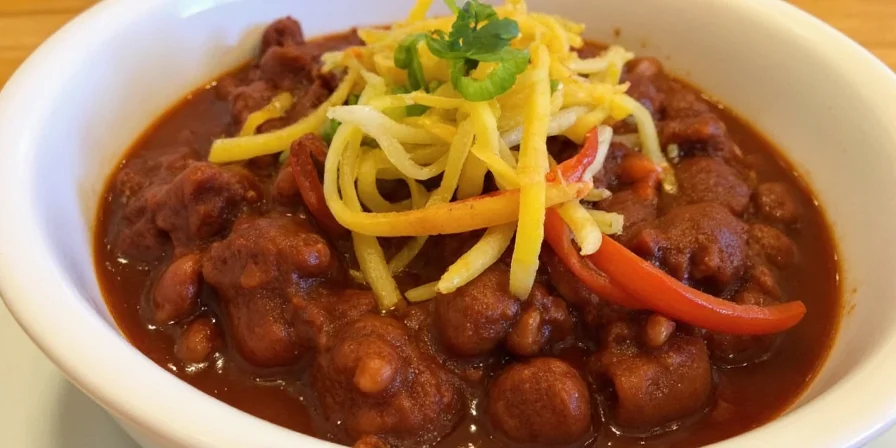Chili Con Carne: A Tale of Spice, Meat, and Borderline Identity
Table of Contents
- Introduction
- The Great Chili Debate: Where Was It Born?
- What Makes the Real Deal? The Core Ingredients
- Global Twists: How Different Cultures Make It Their Own
- Spice Up Your Kitchen: Top 5 Tips for Perfect Chili Con Carne
- Conclusion
The Fiery Heart of a Global Dish
Imagine a simmering pot of chili con carne, the aroma of cumin, garlic, and slow-cooked tomatoes filling your kitchen. It's not just a dish—it’s a global conversation. But where did this beloved spicy stew truly originate? The answer isn't as straightforward as you might think.
Let’s take a deep dive into the chili con carne place of origin, its evolution across cultures, and how you can recreate it at home with confidence and flair.
The Great Chili Debate: Texas or Mexico?
Ask ten people where chili con carne was born, and you'll get at least eleven opinions. Some say Texas. Others swear by San Antonio. And then there are those who point south of the border—to Mexico itself.
Texas Claims the Crown
In the U.S., especially in Texas, chili con carne is practically a cultural institution. The dish gained popularity in the late 19th century among Texan cowboys and settlers. Known locally as “chili,” it became famous through street vendors and later at the 1893 Chicago World’s Fair.
Texas-style chili, or “bowl o’red” as some call it, traditionally uses coarsely ground beef, dried chilies (like ancho or New Mexico), and spices—no beans!
San Antonio Says Otherwise
Some food historians argue that chili con carne has deeper roots in San Antonio, Texas, where Tejano communities made a version called “chili gravy.” This sauce-like concoction was often served over rice or with crackers.
But What About Mexico?
Mexican culinary experts roll their eyes at American claims. After all, chili-based dishes have been around for centuries. One such precursor is “carne con chile,” a dish of meat cooked in a rich chili sauce, commonly found in regions like Chihuahua and Coahuila.
| Region | Claim to Fame | Signature Style |
|---|---|---|
| Texas, USA | Bowl o' Red Championships | No beans, thick sauce, coarse meat |
| San Antonio, USA | Tejano origins | Gravy-like texture, served with crackers |
| Northern Mexico | Carne con Chile | Long-simmered, regional chilies used |
Breaking Down the Base: What Goes Into Authentic Chili?
Whether you’re team Texas or team Mexico, certain ingredients are essential:
- Meat: Beef chuck or brisket is best—slow cooking makes it tender and rich.
- Chilies: Ancho, guajillo, or New Mexico chilies provide depth. Dried chilies need rehydrating and blending for sauce.
- Spices: Cumin, smoked paprika, garlic powder, oregano, and a touch of cinnamon bring warmth and complexity.
- Liquids: Stock, tomato paste, and sometimes beer or coffee add body and richness.
- Optional Add-ons: Beans (if you're non-Texan), onions, bell peppers, and a splash of vinegar or lime juice for brightness.
Global Twists: How the World Has Adopted Chili Con Carne
Chili con carne has become a global citizen. Here’s how different countries interpret it:
- United Kingdom: Often includes kidney beans and is served over spaghetti (yes, really).
- Germany: Served in a bread roll as a fast-food option.
- Japan: Sometimes made with chicken and has a sweeter profile due to soy sauce and mirin.
- Australia: Topped with cheese, sour cream, and avocado on nachos or baked potatoes.
- South Africa: Made with game meats like ostrich or springbok and spiced with curry powder.

Spice Up Your Kitchen: Top 5 Tips for Perfect Chili Con Carne
- Dry Roast Those Chilies: Toasting dried chilies before soaking them adds a nutty depth you won’t want to skip.
- Make It Ahead: Chili tastes better the next day. Letting it rest overnight allows flavors to marry beautifully.
- Low and Slow: Simmer your chili for at least 1.5–2 hours. Rushing it means missing out on flavor development.
- Balance Is Key: Sweetness (from tomatoes or sugar), acidity (vinegar/lime), salt, and spice should be in harmony. Taste and adjust as you go.
- Garnish Like a Pro: Fresh cilantro, diced onions, shredded cheese, sour cream, avocado slices, and lime wedges turn a bowl of chili into a feast.
Chili Con Carne: More Than Just a Dish
So where did chili con carne come from? The truth is somewhere between San Antonio’s streets, Northern Mexican kitchens, and Texan cowboy camps. Whether you lean toward the smoky simplicity of Texas or the layered richness of Mexican carne con chile, one thing’s clear—this dish has soul.
It’s a perfect example of how spices and traditions cross borders and evolve. So fire up your pot, grab your favorite spices, and remember: no matter what your recipe says, the best chili is the one you love most.











 浙公网安备
33010002000092号
浙公网安备
33010002000092号 浙B2-20120091-4
浙B2-20120091-4